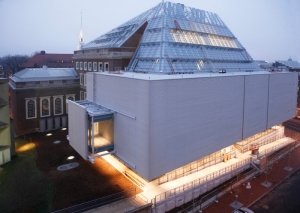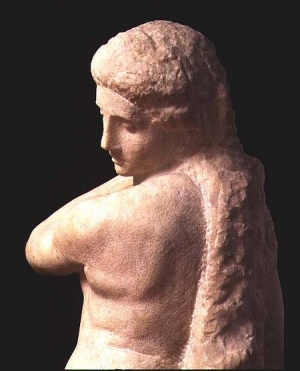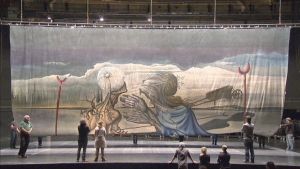|
Displaying items by tag: theater
Though “Dance: Movement, Rhythm, Spectacle” occupies just one large room (arranged to feel like three) at the Philadelphia Museum of Art, it seems to open windows in many directions. Its exhibits range from the 1890s to the 1980s, vividly demonstrating how radically that century brought change to social dance, dance theater and ideas of dance in art. Diversely diverse, the show, which opened this month, offers a panoply of artistic media (photographs, paintings, watercolors, prints, woodcuts, etchings, graphite drawings, lithographs and film), dancers of various races and a huge assortment of dance costumes.

Dr. Louise Mirrer, President and CEO of the New-York Historical Society, today announced plans for the establishment of a new Center for the Study of Women’s History, located on New-York Historical’s fourth floor within a fully-renovated Henry Luce III Center for the Study of American Culture. A model of innovation, the new Center will include permanent and temporary exhibition galleries and a theater featuring a multimedia film, providing a venue for scholarly research, seminars, and public programs that bridge the gap between “women’s history” and American history. The new Center is scheduled to open in December 2016.
“The new Center for Women’s History will become a destination for discovery of the crucial role that New York women played in our nation’s social, political, and cultural evolution as women struggled for and eventually won the right to vote,” said Dr. Mirrer. “We will highlight the women who changed the course of our history, giving voice, in many cases, to the voiceless, who ushered in the Progressive era and emerged triumphant in the struggle for women’s suffrage.”
The National Portrait Gallery will stage a major exhibition in 2015 of works by one of the world’s most celebrated portrait painters, John Singer Sargent. Organized in partnership with the Metropolitan Museum of Art in New York, the exhibition will bring together, for the first time, a collection of the artist’s intimate and informal portraits of his impressive circle of friends, including Robert Louis Stevenson, Claude Monet and Auguste Rodin.
Curated by Richard Ormond CBE, co-author of the John Singer Sargent catalogue raisonné, the exhibition "Sargent: Portraits of Artists and Friends" (12 February – 25 May 2015) will explore the artist as a painter at the forefront of contemporary movements in the arts, music, literature and theater, revealing the depth of his appreciation of culture and his close friendships with many of the leading artists, actors and writers of the time.
After a two-stage competition, New York-based architecture firm Thomas Phifer and Partners has been selected to design Poland’s forthcoming Warsaw Museum of Modern Art. The company beat out eleven competitors, including Foster + Partners (New York), Henning Larsen (Copenhagen), and UNstudio (Amsterdam). The 161,000-square-foot museum will be located in Warsaw’s Parade Square, one of the largest city squares in the world. The museum, which will feature a large performance space for the TZ Warszawa theater, is expected to significantly boost Poland’s presence in the contemporary art world.
Phifer and Partners’ proposal included plans for a glass-walled museum that will promote transparency to the public and connectivity to the overall city. In his design, Phifer followed the idea that the institution is “a building that reveals all it has.”

On November 16, 2014, the Harvard Art Museums -- including the Busch-Reisinger Museum, the Arthur M. Sackler Museum, and the Fogg Museum of Art -- will reopen to the public under one state-of-the art roof. The project, which began in 2008, has entailed a complete renovation and expansion of Harvard’s museum system. The endeavor has increased gallery space by 40 percent, for a total of approximately 43,000 square feet.
Harvard tapped renowned architect Renzo Piano to transform 32 Quincy Street in Cambridge, Massachusetts, the landmark building that previously housed the Fogg and Busch-Reisinger Museum, into the university’s artistic hub. The new facility combines the 32 Quincy Street building, which was constructed in 1927, with a new addition and a striking glass rooftop structure that will allow controlled natural light into the facility’s conservation lab, study centers, and galleries. The overhaul also includes a theater for lectures and public programming.
The Busch-Reisinger Museum, which was founded in 1903, is the only museum in North America dedicated to the art of the German-speaking countries of Central and Northern Europe. The Fogg Art Museum, which opened to the public in 1896, boasts extensive holdings of American and European art from the Middle Ages to the present. The Arthur M. Sackler Museum, which holds a remarkable Asian art collection, was established in 1985 in a separate building from the Fogg and Busch-Reisinger. The museum has been closed since June to prepare for its relocation to the new facility.
Thomas W. Lentz, the Elizabeth and John Moors Cabot Director of the Harvard Art Museums, said, “We knew that we had an opportunity to redefine the Harvard Art Museums as an accessible and connected 21st-century facility for teaching and learning, so we engaged Renzo Piano to design a building to implement that vision. We asked him to design it from the inside out—to create a new kind of laboratory for the fine arts that would support our mission of teaching across disciplines, conducting research, and training museum professionals. We also wanted to strengthen the museums’ role as an integral part of Cambridge and Boston’s cultural ecosystem. We look forward to welcoming students, faculty, and staff at Harvard, our Cambridge friends and neighbors, the entire Greater Boston community, and travelers from afar into our new home this November.”

The Smithsonian Institution in Washington, D.C. announced that Oprah Winfrey will donate $12 million to support the capital campaign of the new National Museum of African American History and Culture. Winfrey donated $1 million in 2007, bringing her total contribution to the project to $13 million. She has been a member of the museum’s advisory council since 2004. To thank her for her generosity, the Smithsonian will name the museum’s 350-seat theater the Oprah Winfrey Theater.
The museum, which is currently under construction, is expected to cost $500 million by the time it reaches completion. Congressional funding provided half of the capital and the rest is being raised by the museum. The museum is situated on 5 acres of land and sits next to the Washington Monument. It will be the 19th Smithsonian museum.
Wayne Clough, the Smithsonian Secretary, said, “At its heart, the National Museum of African History and Culture is a showcase for a richer, fuller picture of the American experience. The Oprah Winfrey Theater will bring untold stories alive through films, performances, artistic expression and public dialogue.”
The National Museum of African American History and Culture is slated to open in late 2015.

The Speed Art Museum in Louisville, KY announced that it has exceeded its $50 million fundraising goal for its Changing Speed expansion and renovation project by $334,000. The campaign’s success will allow the museum to complete Phase I and II of its plan, which includes building a new North Building, a central utilities building, and an art park and piazza.
The New North Building will span 62,500-square-feet and will double the museum’s overall physical space. The state-of-the-art renovation will include larger spaces for special exhibitions, contemporary art galleries, a family education welcome center, indoor and outdoor cafes, a museum shop, and a multifunctional pavilion for lectures and performances.
A major family gift made by civic leader Christy Brown will allow the Speed Art Museum to complete Phase III of its plan, which includes building a new South Building and extensive renovations to the existing structure. Brown made an $18 million contribution to the project in honor of her late husband, Owsley Brown II. The new 9,500-square-foot South Building will include additional gallery space and a state-of-the-art theater that will be capable of showing 16mm and 35mm films. The South Building will also include a renovated 5,600-square-foot gallery in the Speed’s current structure to house the museum’s significant collection of early Kentucky fine and decorative arts, which includes paintings, sculptures, furniture, silver, and other objects.
Work on Phase III of the Speed’s plan is underway and Phase I and II are expected to start this summer. All construction and renovations are expected to reach completion by the winter of 2015 and a grand re-opening is slated for early 2016.
Louisville philanthropist Hattie Bishop Speed founded the Speed Art Museum in 1925. It is the oldest, largest, and foremost art museum in Kentucky. The Speed is currently closed for the renovations but a temporary exhibition space was established in downtown Louisville’s Nulu district.

Officials at Harvard University in Cambridge, MA announced that they will open the newly renovated and expanded Harvard Art Museums in the fall of 2014. The project, which began in 2008, has entailed a complete reinvention of Harvard’s museum system and will place the Busch-Reisinger Museum, the Arthur M. Sackler Museum, and the Fogg Museum of Art under one state-of-the-art roof.
Renowned architect Renzo Piano was enlisted to transform 32 Quincy Street, the landmark building that currently houses the Fogg and Busch-Reisinger museums, into Harvard’s artistic hub. The new facility will combine the 32 Quincy Street building, which was constructed in 1927, with a new addition and a striking glass rooftop structure that will allow controlled natural light into the facility’s conservation lab, study centers, and galleries. The overhaul also includes a theater for lectures and public programming.
The Arthur M. Sackler Museum, which was established in 1985 in a separate building from the Fogg and Busch-Reisinger, has remained open during the recent construction. The Sackler will close June 1, 2013 to prepare for the relocation of its remarkable Asian art collection to 32 Quincy Street.
The Bush-Reisinger Museum, which was founded in 1903, is the only museum in North America dedicated to the art from the German-speaking countries of Central and Northern Europe. The Fogg Art Museum, which opened to the public in 1896, boasts extensive holdings of American and European art from the Middle Ages to the present.

As part of a yearlong celebration of Italian culture hosted by Italy’s foreign minister, Michelangelo’s (1475-1564) iconic work, David-Apollo, will be go on view today at the National Gallery of Art in Washington, D.C. Minister Giulio Terzi di Sant’Agata unveiled the sculpture yesterday, December 12. David-Apollo will be on view in the West Building’s Italian galleries through March 3, 2013.
Michelangelo carved David-Apollo in 1530 for Baccio Valori, who served as the interim governor of Florence per the Medici pope Clement VII’s appointment. Michelangelo and the pope were at political odds, but the artist wished to make peace with the Medici through his work. Michelangelo never finished David-Apollo as he left Italy and never returned after Clement VII’s death.
Part of the Museo Nazionale del Barello’s collection in Florence, David-Apollo traveled to the National Gallery once before in 1949. The masterpiece’s installation in Washington over sixty years ago coincided with former president Harry Truman’s inaugural reception and attracted more than 791,000 visitors. In 2013, David-Apollo’s presentation will coincide with President Barack Obama’s inauguration.
The Year of Italian Culture, launched by Sant’Agata under the auspices of the President of the Italian Republic, Giorgio Napolitano, will bring a range of Italian masterpieces to nearly 70 cultural institutions across the United States. Works range from classical and Renaissance to baroque and contemporary and cover the realms of art, music, theater, cinema, literature, science, design, fashion, and cuisine.

This past Sunday, Montreal's Place des Arts and the stage troupe Finzi Pasca unveiled a mural by Salvador Dali that has remained out of public view for sixty years. Measuring 29 ½ feet by 40 feet, the backdrop was painted for the 1944 ballet production “Le Tristan Fou (Mad Tristan),” a take on “Tristan und Isolde,” while the Surrealist artist was in exile in New York. The backdrop made an appearance in London in 1949 and then fell out of sight until an anonymous European foundation re-discovered it three years ago.
The rare piece was restored but rather than exhibit it in a museum of gallery, the foundation offered it to theater creator and circus master Daniele Finzi Pasca for use in an upcoming acrobatic stage production. Pasca decided to incorporate the painting into “La Vérità,” a story inspired by “Tristan und Isolde” as well as Dali’s exile, the 1940s cabaret scene, and the Dali’s wife and muse, Gala.
Members of the public can take a closer look at the Dali backdrop at Théâtre Maisonneuve in Place des Arts on Wednesday, November 7. La Vérità, featuring the Dali backdrop will premiere at the theater on January 17, 2013.
|
|
|
|
|